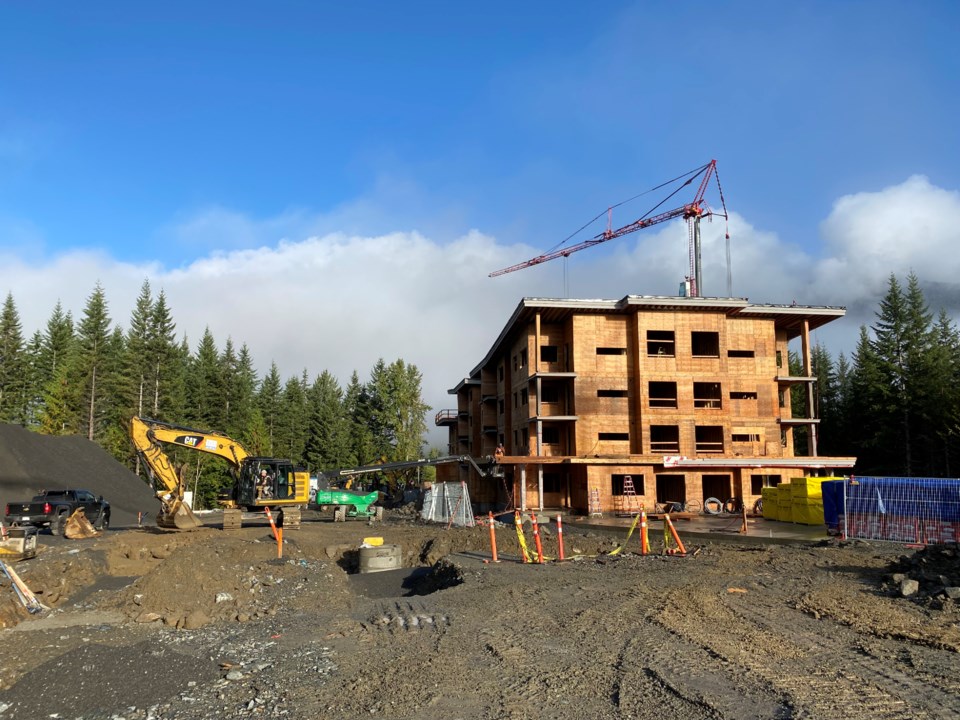Whistler’s mayor and council gave their assent to a $14 million loan agreement between the Whistler 2020 Development Corp (WDC) and the Royal Bank of Canada at the Oct. 19 council meeting, paving the way for work to continue on employee housing in Cheakamus Crossing—but the agreement doesn’t come without risk.
The Resort Municipality of Whistler (RMOW) itself is not borrowing the money, noted director of finance Carlee Price in a presentation to council, but RBC requires security for the loan.
“That security is the land that encompasses Lots 1 and 4 (in Cheakamus Crossing’s Phase 2),” Price said. “The RMOW holds title to these lands in trust for WDC. That means that the RMOW is necessarily involved both in vetting the documents, and in signing them.”
The $14 million alone won’t cover the total spend on Cheakamus Crossing Phase 2 (expected to be about $43 million), but will allow work to continue into the winter, while also allowing WDC time to sell the 23 market lots on Lot 4 (known as Riverrun—sales are expected to begin later this year).
“The profits from these sales directly support the ongoing development and construction of the new employee-restricted housing opportunities in Cheakamus Crossing,” said Mayor Jack Crompton at the meeting.
“Providing more employee housing has been a real focus for this council since day one, and this process is part of how we’re making that focus a reality.”
One of the goals of the RMOW through the lending process was to ensure that no additional municipal resources would be available to RBC, limiting the extent of the lending to Lots 1 and 4 (worth about $33 million for the purposes of the loan), and excluding any financial resources of the RMOW, Price said.
Much work was undertaken to ensure the risk being assumed by the RMOW is acceptable, she added, noting in a report to council that both the WDC and RMOW agree that “in no case should the ratepayers of this community be left financially liable for actions taken by subsidiary corps in pursuit of employee housing.”
With that in mind, “the loan documents have been structured to minimize the risk to the RMOW, but they cannot fully eliminate it,” Price said, and language was added to the loan documents to protect against negative outcomes.
WDC’s ability to repay the loan relies entirely on the sale of the 23 market lots on Lot 4 and 100 units currently under construction on Lot 1—and while a default scenario is unlikely, it’s not impossible, Price noted.
“This specific outcome could be the result of higher costs; it could also be the result of lower asset prices,” she said. “We of course today have the added benefit of selling these lots into an extremely hot real estate market, but that isn’t guaranteed to be the case going forward.”
As such, the language in the loan documents specifically limits any potential RBC claims to the two lots in question, and the bank will receive 100 per cent of the net sales proceeds from the lots (which the WDC expects to be worth about $56 million) until the borrowing is repaid.
If worse came to worst, there is also the potential risk (albeit a slim one) that RBC could ultimately come to own the non-market lands and employee-restricted buildings, Price said in her report.
“It is essential then that intended use of these buildings survive any such transfer, to ensure that the bank could not, for example, turn these into market condos,” she said.
That possibility is avoided via a housing agreement covenant registered on title for Lot 1, which takes precedence over the RBC mortgage and maintains the intended use of employee-restricted housing.
The loan documents can be found in the Oct. 19 council agenda starting on page 42: www.whistler.ca/municipal-gov/council/meeting-agendas-and-minutes.





